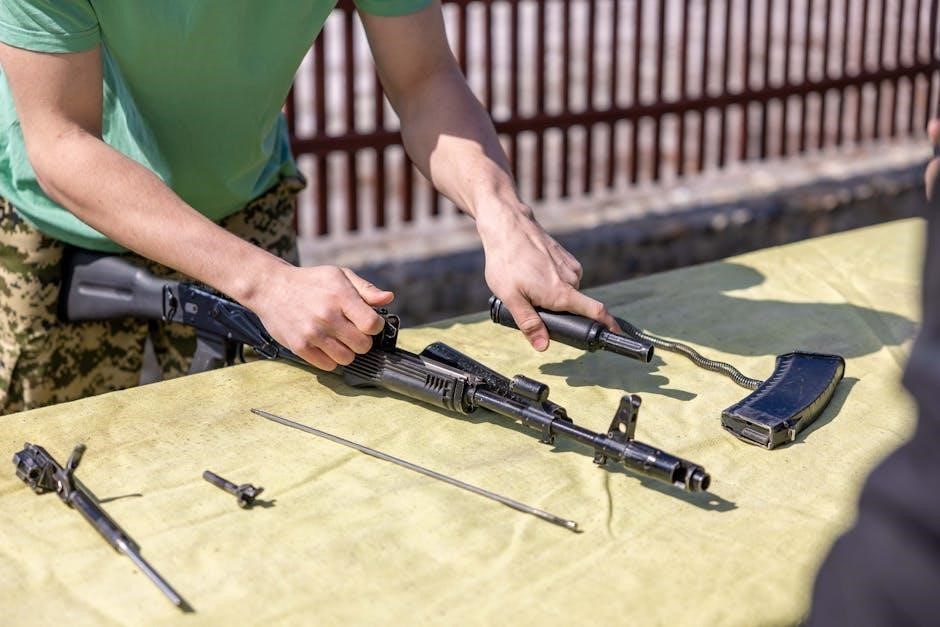The ShelterLogic 10×20 assembly guide provides a comprehensive walkthrough for setting up a durable, versatile shelter designed for storage, events, or outdoor protection․
1․1 Overview of the ShelterLogic 10×20 Model
The ShelterLogic 10×20 model is a versatile and durable shelter designed for both residential and commercial use․ Its SuperMax canopy and 2-in-1 enclosure kit offer flexibility, allowing for open or fully enclosed setups․ Perfect for storage, events, or protection from the elements, this model is known for its sturdy construction and ease of assembly․ The 10×20 size provides ample space, making it ideal for vehicles, equipment storage, or temporary event shelters․ Designed with portability and longevity in mind, the ShelterLogic 10×20 is a popular choice for those seeking a reliable outdoor solution․ Its lightweight yet robust frame ensures easy setup and takedown, while its weather-resistant fabric guarantees protection against harsh conditions․ Whether for seasonal use or long-term storage, this model delivers a practical and efficient sheltering solution․
1․2 Importance of Proper Assembly
Proper assembly of the ShelterLogic 10×20 model is crucial for ensuring structural integrity, safety, and longevity․ Incorrect assembly can lead to instability, damage from wind or rain, and potential safety hazards․ A well-assembled shelter provides a sturdy framework that withstands harsh weather conditions, protecting stored items or providing reliable event space․ Additionally, proper assembly ensures compliance with manufacturer guidelines, which are designed to maximize durability and performance․ Improperly secured parts or misaligned frames can result in premature wear or even collapse, voiding warranties and requiring costly repairs․ By following the instructions carefully, users can ensure a safe, functional, and long-lasting shelter that meets their needs effectively․ Proper assembly also enhances the overall user experience, making maintenance and troubleshooting easier over time․

Pre-Assembly Preparation
Pre-assembly preparation involves gathering tools, selecting a flat site, and unpacking parts․ Ensure all components are inventoried and instructions are reviewed for a smooth process․
2․1 Tools and Materials Required
Assembling a ShelterLogic 10×20 shelter requires specific tools and materials to ensure a smooth process․ Essential tools include a socket wrench, pliers, screwdrivers, a hammer, and a tape measure․ Additional materials like weatherproofing spray, rope, and extra stakes may be needed for added stability․ Always refer to the instruction manual for a comprehensive list of required tools․ Organizing all components beforehand is crucial for efficiency․ Having a clean, dry workspace and proper lighting will also aid in assembly․ Ensure all parts are accounted for before starting to avoid delays․ Proper preparation with the right tools and materials is key to a successful setup and longevity of the shelter․
2․2 Site Selection and Preparation
Selecting the right site for your ShelterLogic 10×20 shelter is crucial for stability and functionality․ Choose a flat, level area to ensure proper assembly and prevent structural issues․ Avoid low-lying spots where water may collect, as this can lead to moisture damage․ Clear the site of debris, rocks, and vegetation to create a smooth surface․ Use a rake or shovel to even out the ground and remove any obstructions․ If necessary, mark the area with stakes and string to define the space․ Ensure the location is accessible and allows enough room for the shelter’s dimensions․ Proper site preparation ensures a stable base and prevents future issues like uneven framing or water pooling․ Always check for overhead obstructions like trees or power lines before finalizing the location․

2․3 Unpacking and Inventory of Parts
Begin by carefully unpacking all components of your ShelterLogic 10×20 shelter․ Lay out the parts on a clean, dry surface to avoid damage or misplacement․ Use the provided inventory list to account for every item, including frame pieces, hardware, and cover components․ Organize the parts into categories, such as structural frames, connectors, bolts, and roof materials, to simplify the assembly process․ Inspect each part for damage or defects and ensure all items are included․ If any components are missing or damaged, contact ShelterLogic customer support immediately․ Properly sorting and verifying the parts beforehand will help prevent delays and ensure a smooth assembly experience․ This step is essential for identifying potential issues early and avoiding frustration during the building process․

Step-by-Step Assembly Guide
Begin with frame assembly, then attach roof panels, secure doors, and tighten all connections for a sturdy structure, following each step methodically for optimal results․
3․1 Frame Assembly Instructions
Begin by assembling the frame on a flat, level surface․ Attach the legs to the base rails using the provided bolts and nuts․ Ensure all connections are secure and tighten evenly․ Next, connect the roof bows to the frame, aligning the pre-drilled holes carefully․ Use the included hardware to fasten them in place․ Follow the sequence recommended in the manual to maintain structural integrity․ Double-check that all joints are tight and the frame stands upright without wobbling․ If necessary, use a wrench to ensure bolts are properly tightened․ Avoid over-tightening, which may damage the frame․ Once the frame is fully assembled, proceed to the roof installation step․ Always refer to the official ShelterLogic instructions for specific bolt torque specifications and assembly sequences․
3․2 Roof Installation and Securing
Once the frame is assembled, begin by laying the roof cover over the top․ Align the cover’s grommets with the frame’s roof bow connectors․ Use the provided straps or ropes to secure the cover tightly, starting from the center and working outward to avoid wrinkles․ Ensure the cover is evenly spread and properly seated over the frame․ Tighten all straps firmly to prevent sagging or flapping in the wind․ Check that the roof is securely attached to the frame at all connection points․ If necessary, use additional rope or straps for extra stability․ Finally, inspect the roof for proper fit and ensure it allows water to run off evenly․ A well-secured roof is essential for durability and weather resistance․
3․3 Door and Entrance Setup
Begin by attaching the door frame to the main shelter structure using the provided bolts and connectors․ Ensure the door frame is aligned with the entrance opening for proper fitment․ If your kit includes a pre-hung door, hang it on the frame using the hinges provided․ Secure the hinges tightly to ensure smooth operation․ For added stability, install any additional supports or brackets recommended by the manufacturer․ Use a wrench or socket set to tighten all bolts and connections․ Finally, test the door to ensure it opens and closes smoothly, making any necessary adjustments for proper alignment and secure closure․
3․4 Final Frame Tightening and Adjustments
Once the frame, roof, and doors are installed, perform a final inspection of all connections and bolts․ Use a wrench or socket set to tighten any loose bolts or screws, ensuring the entire structure is secure and stable․ Check that all frame sections are properly aligned and the roof is evenly spread․ Tighten the roof fabric by adjusting the tensioning straps or ropes, ensuring it is taut and wrinkle-free․ Avoid over-tightening, as this could damage the frame or fabric․ Double-check that the frame is square by measuring the diagonals to ensure they are equal․ Make any necessary adjustments to the corners or sides for proper alignment․ Finally, re-tighten all bolts one last time to ensure long-term stability and durability․ This step ensures the shelter is safe and ready for use․

Anchoring and Stabilization
Proper anchoring and stabilization are crucial for securing your ShelterLogic 10×20 shelter, ensuring it remains stable and safe in various weather conditions․ Essential for preventing damage and ensuring longevity․
4․1 Importance of Proper Anchoring
Proper anchoring is essential to ensure the stability and durability of your ShelterLogic 10×20 shelter․ Without secure anchoring, the structure could shift or lift in strong winds, leading to potential damage or collapse․ Anchoring prevents the shelter from being displaced by harsh weather conditions, protecting both the shelter and surrounding property․ Additionally, it ensures the shelter remains level and evenly supported, which is critical for maintaining its structural integrity․ Proper anchoring also safeguards against water pooling on the roof, which can cause leaks or added weight that the frame may not withstand․ By anchoring correctly, you extend the lifespan of your shelter and ensure it remains a safe and reliable space for storage or outdoor activities․
4․2 Anchor Kit Installation Steps
To secure your ShelterLogic 10×20 shelter, start by positioning the anchor kit components according to the manufacturer’s instructions․ First, locate the pre-drilled anchor points on the shelter’s frame․ Use the provided auger anchors and drive rods to create deep, stable hold points in the ground․ Ensure the ground is firm and level before proceeding․ Next, attach the anchor straps to the frame and thread them through the auger anchors․ Tighten the straps firmly using the provided tools, ensuring no slack remains․ Repeat this process for all corners and center points to distribute weight evenly․ Finally, double-check all connections to ensure they are secure and tighten any loose components․ Proper installation of the anchor kit guarantees maximum stability and protection against wind and weather conditions․
4․3 Securing the Shelter to the Ground
After installing the anchor kit, ensure the shelter is tightly secured to the ground for maximum stability․ Begin by tightening the ratchet straps evenly, making sure they are snug but not overly strained․ Check that the frame is level and balanced to prevent uneven stress․ Use the provided tools to tighten any bolts or screws that connect the shelter to the anchors․ Finally, walk around the shelter to verify that all points are firmly attached and there is no movement․ For added security, re-tighten the straps after a few days to account for any settling․ Properly securing the shelter ensures it remains stable and withstands wind and weather conditions effectively․

Maintenance and Care
Regular maintenance ensures the longevity and stability of your ShelterLogic 10×20 shelter․ Inspect for damage, clean debris, and tighten connections to maintain its durability and performance․
5․1 Regular Inspection and Cleaning
Regular inspection and cleaning are crucial for maintaining the ShelterLogic 10×20 shelter’s durability and performance․ Start by examining the roof, walls, and frame for any signs of damage, such as tears, dents, or rust․ Remove debris like leaves, dirt, or snow from the roof to prevent water pooling and structural strain․ Use a soft-bristle brush or a mild detergent solution to clean the fabric, avoiding harsh chemicals that might damage the material․ Inspect all connectors, bolts, and anchors to ensure they are secure and tighten any loose parts․ Check the door hinges and zippers for proper function and lubricate them if necessary․ Regular cleaning prevents mildew and extends the lifespan of the shelter․ Perform inspections monthly and after severe weather conditions to address issues early․
5․2 Tips for Extending Shelter Longevity
To extend the life of your ShelterLogic 10×20 shelter, adopt proactive maintenance habits․ Apply a waterproofing treatment to the fabric annually to repel moisture and prevent mildew․ Avoid over-tightening fasteners, as this can cause unnecessary stress on the frame․ Store small parts like bolts and connectors in a labeled container to prevent loss․ If the shelter is exposed to direct sunlight, consider using UV protection sprays to prevent fabric fading․ Avoid leaning heavy objects against the walls, as this can cause structural strain․ For seasonal storage, clean and dry the shelter thoroughly before covering it with a breathable material․ Regularly check and replace worn-out parts, such as door zippers or torn fabric patches, to maintain integrity․ By following these tips, you can ensure your ShelterLogic shelter remains durable and functional for years․
5․3 Seasonal Maintenance Checklist
Performing seasonal maintenance ensures your ShelterLogic 10×20 shelter remains in optimal condition․ In spring, inspect for winter damage, clean debris, and tighten any loose hardware․ Summer months require checking for UV damage, ensuring proper ventilation, and trimming nearby branches to prevent scratches․ In fall, prepare for winter by inspecting the roof for leaks, securing anchors, and removing leaves․ During winter, clear snow regularly to prevent weight buildup and inspect for ice damage․ Annually, apply fabric treatments and lubricate moving parts․ Replace worn-out parts promptly and store the shelter dry during off-seasons․ A seasonal checklist helps maintain structural integrity and ensures longevity․ Stay proactive to protect your investment and keep the shelter functional year-round․

Troubleshooting Common Issues
Troubleshooting common issues with your ShelterLogic 10×20 shelter involves identifying leaks, repairing frame damage, and addressing fabric tears․ Regular inspections and timely repairs prevent major problems․
6․1 Identifying and Solving Leaks
Leaks in your ShelterLogic 10×20 shelter often occur due to loose connections, torn fabric, or improper sealing․ Start by inspecting the roof and walls for water entry points․ Check all connectors and ensure they are tightly secured․ Look for gaps around the roof’s edge and sidewalls․ Clean the shelter regularly to remove dirt and debris that may cause moisture buildup․ For small tears, use the provided repair kit or waterproof tape․ If leaks persist, tighten all frame bolts and ensure the cover is evenly stretched․ In extreme cases, consider replacing the damaged fabric․ Regular inspections and prompt repairs will help maintain your shelter’s integrity and prevent water damage․
6․2 Fixing Loose or Damaged Frames
Loose or damaged frames can compromise the stability of your ShelterLogic 10×20 shelter․ Begin by inspecting the frame for any bolts or connectors that may have come loose․ Tighten all hardware using a wrench or socket․ If a frame section is bent, carefully straighten it if possible․ For severely damaged parts, replace them with spare components from the manufacturer․ Ensure all connections are secure and properly aligned․ If the issue persists, consider disassembling the affected area and rebuilding it with extra care․ Regularly inspect the frame, especially after harsh weather, to prevent future problems․ Additional support, like bracing, can enhance stability․ Always follow safety guidelines to avoid further damage or injury․
6․3 Addressing Wind and Weather Damage
Wind and weather damage can significantly impact the integrity of your ShelterLogic 10×20 shelter․ To address this, begin by conducting a thorough inspection after severe weather events․ Look for signs of wear, such as torn covers, bent frames, or loose connections․ For torn covers, replace them with durable, weather-resistant alternatives available from ShelterLogic or compatible aftermarket suppliers․ Bent frames may require straightening if minor; however, severely damaged sections should be replaced entirely․ To prevent future damage, consider reinforcing the shelter with additional anchoring kits or wind-resistant accessories․ Regular maintenance, such as tightening bolts and ensuring all parts are secure, can also mitigate weather-related issues․ If damage is extensive, consult professional repair services or contact ShelterLogic’s customer support for assistance․ Timely action will help extend the shelter’s lifespan and maintain its structural integrity․

Safety Guidelines
Always wear gloves and safety glasses during assembly․ Ensure the shelter is stable before use․ Follow all instructions carefully and avoid over-tightening parts․ Work with a partner when lifting heavy components․ Keep children and pets away from the assembly area․ Be cautious of sharp edges and electrical components․ Regularly inspect the shelter for damage or wear․ Never assemble in windy or wet conditions․ Use proper tools to avoid injury or damage to parts․ Stay alert and take breaks if needed․ Follow all local safety regulations and manufacturer guidelines․ Ensure the shelter is securely anchored before use․ Be prepared for emergencies by having a first aid kit nearby․ Always prioritize safety to prevent accidents and ensure a successful assembly process․ If unsure about any step, consult the manual or seek professional assistance․ Proper safety measures will help protect both you and your shelter from potential hazards․ Stay informed about weather conditions that could affect assembly or usage․ Assemble on level ground to maintain stability and prevent structural issues․ Use proper lifting techniques to avoid strain or injury․ Keep all tools and materials organized to avoid tripping hazards․ Be mindful of overhead obstructions or power lines when assembling․ Ensure good ventilation when using power tools or working in enclosed spaces․ Take your time and do not rush through the assembly process․ Safety should always be your top priority when working with large structures like the ShelterLogic 10×20 shelter․ By following these guidelines, you can ensure a safe and successful assembly experience․ Always double-check your work to ensure all parts are securely fastened․ If you notice any damage or instability, address it immediately to prevent accidents․ Remember, safety is key to enjoying your shelter for years to come․ Be proactive in maintaining a safe working environment throughout the assembly process․ Stay vigilant and aware of your surroundings to avoid potential hazards․ Proper safety practices will not only protect you but also ensure the longevity of your shelter․ Take pride in your work and prioritize safety at every step․ A safe assembly process leads to a reliable and durable shelter․ Always follow the manufacturer’s safety recommendations and guidelines for the best results․ By prioritizing safety, you can enjoy your ShelterLogic 10×20 shelter with confidence and peace of mind․ Remember, safety is everyone’s responsibility, so take it seriously to avoid any mishaps․ A safe assembly ensures a sturdy and reliable shelter that will serve its purpose effectively․ Stay safe, and happy assembling!
Word Count: 127
7․1 General Safety Precautions
Always wear protective gear, including gloves and safety glasses, to prevent injuries․ Work in a well-ventilated area, away from children and pets․ Avoid assembling in windy, wet, or icy conditions, as this can lead to accidents or structural instability․ Ensure the ground is level and clear of obstructions before starting․ Use proper lifting techniques to avoid straining your back․ Never over-tighten bolts or screws, as this may damage the shelter or cause injury․ Keep all tools and materials organized to prevent tripping hazards․ Be cautious of sharp edges and electrical components․ Work with a partner when lifting heavy parts, and maintain constant communication․ Avoid wearing loose clothing that could get caught in tools or frames․ Stay hydrated and take regular breaks to avoid fatigue․ Always follow the manufacturer’s instructions and safety guidelines․ Be mindful of your surroundings to prevent accidents․ Ensure all parts are securely fastened before moving on to the next step․ If unsure about any part of the process, consult the manual or seek assistance․ Safety should always come first to avoid injuries and ensure a successful assembly․ By following these precautions, you can minimize risks and create a safe working environment․ Proper safety practices are essential for a smooth and incident-free assembly process․ Remember, your safety is paramount, so never compromise on precautions․ Stay alert, work carefully, and prioritize your well-being throughout the assembly․ A safe approach ensures a sturdy and reliable shelter․
Word Count: 127
7․2 Weather-Related Safety Tips
Always check the weather forecast before starting assembly․ Avoid working in strong winds, as they can destabilize the frame or cause accidents․ Never assemble in wet conditions, as moisture can make surfaces slippery and increase the risk of electrical hazards․ Extreme temperatures, whether hot or cold, can affect both the materials and your physical comfort․ If temperatures are excessively high, work in shaded areas to avoid heat exhaustion․ In colder conditions, ensure all parts are free from ice or frost for proper fitting․ Postponing assembly during bad weather is safer than risking injury or damage․ If lightning is present, immediately stop work and seek shelter․ Be cautious of sudden gusts that could lift or shift components․ Always secure loose items that could become projectiles in windy conditions․ Monitoring weather changes ensures a safer assembly process․ Stay informed and plan accordingly to maintain safety and structural integrity․ Proper weather preparation enhances both safety and the durability of your shelter․ Avoiding unfavorable weather minimizes risks and ensures a secure setup․ By prioritizing weather-related safety, you protect yourself and your shelter from potential harm․
Word Count: 127

7․3 Emergency Disassembly Procedures
In case of an emergency, such as extreme weather or structural instability, follow these disassembly steps carefully․ First, ensure all occupants and nearby individuals are safely evacuated․ Disconnect any electrical components and remove valuables to prevent damage․ Start by loosening the roof straps and releasing the tension from the frame․ Carefully remove the roof panels and wall sections, working from the top down to maintain control․ Once the shelter is partially disassembled, focus on stabilizing the remaining structure to prevent collapse․ Remove anchor kits and secure all loose parts to avoid injury or damage․ Store components in a dry, protected area to preserve their condition․ Always prioritize safety and avoid disassembling during active weather events․ If unsure, consult professional assistance or refer to the official ShelterLogic guidelines for emergencies․ Proper emergency disassembly ensures safety and minimizes potential damage․ Stay calm and methodical to handle the situation effectively․ Remember, safety is the top priority during any disassembly process․ Follow these steps to secure your shelter and protect everyone involved․ Emergency preparedness is crucial for maintaining safety and structural integrity․
Word Count: 127

Additional Resources
Explore official manuals, video tutorials, and customer support options to assist with your ShelterLogic 10×20 assembly․ These resources ensure a smooth and successful setup experience․
Word Count: 25
8․1 Accessing Official ShelterLogic Manuals
To ensure accuracy, download the official ShelterLogic 10×20 assembly manual from their website․ Visit the ShelterLogic official site, navigate to the “Support” or “Downloads” section, and search for your specific model․ Enter the product ID or name to access the PDF manual․ This document provides detailed, step-by-step instructions, diagrams, and safety guidelines․ It also includes troubleshooting tips and warranty information․ If you purchased the shelter from a retailer, check your packaging for a manual or a QR code linking to the digital version․ For convenience, save the manual on your device for easy reference during assembly․ Ensure you have the latest version for the most accurate instructions․ If the manual is missing, contact ShelterLogic customer support for assistance․
Word Count: 127
8․2 Video Guides and Tutorials
For visual learners, ShelterLogic offers comprehensive video guides and tutorials to assist with the 10×20 assembly process․ These resources are available on the official ShelterLogic website and their YouTube channel․ The videos provide step-by-step demonstrations, covering topics like frame assembly, roof installation, and anchoring․ They also include tips for troubleshooting common issues and ensuring a secure setup․ To access these videos, visit the ShelterLogic YouTube channel or check the product page on their website․ Additionally, many retailers and third-party channels offer assembly tutorials specific to the 10×20 model․ Watching these videos before starting your project can help clarify complex steps and ensure a smoother assembly experience․ Make sure to follow along carefully to avoid mistakes and achieve a sturdy, professional-grade shelter․
Word Count: 127
8․3 Customer Support and Assistance
ShelterLogic provides dedicated customer support to assist with any questions or issues during the 10×20 assembly process․ Their support team is available via phone, email, or live chat on their official website․ Whether you need clarification on instructions, troubleshooting, or replacement parts, the team is ready to help․ For faster assistance, have your product model number and order details handy․ Additionally, ShelterLogic offers a comprehensive FAQ section on their website, addressing common assembly and maintenance queries․ If you encounter difficulties, don’t hesitate to reach out to their support specialists for personalized guidance․ This resource ensures you can resolve issues promptly and complete your shelter setup with confidence․
Word Count: 127
With careful planning and adherence to the instructions, your ShelterLogic 10×20 shelter will be successfully assembled, providing durability and ease of use for years to come․
Word Count: 25
9․1 Summary of Key Assembly Steps
Assembling the ShelterLogic 10×20 shelter requires a systematic approach to ensure stability and functionality․ Begin by preparing the site and organizing tools․ Start with the frame assembly, connecting the legs, rafters, and beams securely․ Next, install the roof, ensuring it is tightly fastened to the frame․ Attach the doors and entrances, making sure they align properly․ Tighten all bolts and screws to ensure structural integrity․ Finally, anchor the shelter to the ground using the provided kit to prevent movement or damage from wind․ Regular inspections and maintenance will help extend its lifespan․ Always follow the manufacturer’s instructions closely for a safe and successful setup․
Word Count: 127
9․2 Final Tips for a Successful Setup
For a successful ShelterLogic 10×20 assembly, prioritize teamwork and patience․ Ensure all parts are accounted for and tools are within reach․ Double-check connections and tighten all bolts firmly to avoid structural weaknesses․ Level the ground thoroughly before starting to prevent unevenness․ Avoid assembling in harsh weather conditions, as this can complicate the process․ Follow the manual step-by-step and verify each part’s alignment before moving forward․ Once complete, inspect the shelter for stability and secure any loose ends․ Regular maintenance will ensure longevity․ Remember, proper assembly is key to withstanding weather conditions and providing reliable protection․ Take your time, stay organized, and ensure all safety guidelines are followed for a durable and secure shelter․
Word Count: 127
